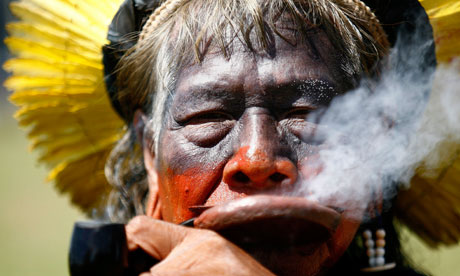Chefe Raoni fotografado por Ueslei Marcelino
The man pictured above is Raoni Txucarramãe, chief of the Kayapó people, who hail from Brazil's northern Pará province. The homeland of the Kayapó is the tropical rainforest surrounding the tributaries of the giant Xingu river, itself a nearly 2,000km long tributary of the Amazon. But the livelihood of the Kayapó people is under grave threat. Brazil's president, Dilma Vana Rousseff, has authorised the construction of a dam that will flood their homeland.
The Belo Monte dam will be the world's third-largest hydroelectric dam (after China's Three Gorges dam, itself with numerous problems, and the Brazilian-Paraguayan Itaipu dam). It will flood 400,000 hectares of the world's largest rainforest, displacing 20,000 to 40,000 people – including the Kayapó. The ecological impact of the project is massive: the Xingu River basin has four times more biodiversity than all of Europe. Flooding of the rainforest will liberate massive amounts of methane, a greenhouse gas far more damaging than carbon dioxide. But the impact on Chief Raoni's people, on an entire society, is unimaginable.
The Kayapó traditionally practised slash-and-burn agriculture on small farms cut into the jungle. The rich resources of their lands (minerals, timber, and potential hydroelectrical power) have brought pressures from outside. Although the Brazilian constitution explicitly prohibits the displacement of "Indians" from their traditional lands, it provides for one convenient exception: where the National Congress deems removal of the people to be "in the interest of the sovereignty of the country". Proponents of the dam argue that its construction is in the nation's interest.
The Kayapó people's leadership has learned how to participate in the world economy. They were one of the first indigenous peoples to participate in international commerce, with the Body Shop, and they learned how to fight back against projects they did not support. A five-day media conference they organised to fight the Bel Monte dam in 1989 generated enough international attention that the World Bank refused the loan necessary for the project to proceed.
Now, as the project raises its head again, the Kayapó have forged alliances with non-profits worldwide to continue their battle. In February, Chief Raoni delivered a petition with 600,000 signatures to the Brazilian government, and construction of the dam was temporarily blocked. But this week, the Brazilian government gave the project the green light.
Chief Raoni and his people have, essentially, played by our rules. They learned the ways of a foreign society, and they waged their battle according to those foreign rules and with those foreign weapons, launching petitions and protests, and engaging media and lawyers. I am reminded of another photo that recently appeared on these pages: that of an "uncontacted" Amazonian tribe, their bows raised, their arrows aimed at the Brazilian Indian Affairs Department aircraft flying overhead. For all his efforts, Chief Raoni, too, might as well have been shooting arrows at the Brazilian National Congress building.
This losing battle is not unique. Rather, it is the common story to the Americas. I recall my visits with Cristina Calderón, known in Chile as "the last Yaghan", the last survivor of her race and last speaker of her native tongue. Across the Beagle Channel from her home lies the large island of Tierra del Fuego, traditional homeland of the Selk'nam, but now devoid of any indigenous people. The demise of the Yaghan was due largely to diseases introduced and spread by displacement from their expansive territories to crowded mission schools. The Selk'nam, however, were actively hunted by European settlers. The new industry here was sheep-ranching. With their traditional hunting territories turned to grazing lands, and with no concept of animals as private property, the Selk'nam turned to hunting sheep. The settlers, in turn, issued a bounty for each pair of Selk'nam ears.
The Kayapó and their partners have launched a last-ditch effort, including another petition, to have the Brazilian government listen to their concerns, and respect traditional land rights. The Inter-American Commission on Human Rights has urged the Brazilian government to consult "in good faith … and with the aim of arriving at an agreement with each of the affected indigenous communities".
But I know, from experience here, where I live – also a land of pristine rainforest that is still populated by vibrant communities of original inhabitants – what industry's requirement to "consult" with indigenous people means: the parties will, at some point, show up in a room together and voice their opinions. The indigenous people will have every right to say no to the project. But no one is required to heed that.
publicado no The Guardian
























0 comentários:
Postar um comentário